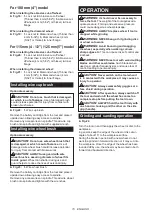
15 ENGLISH
For 100 mm (4″) model
When installing the abrasive cut-off wheel:
►
Fig.18:
1.
Lock nut
2.
Abrasive cut-off wheel
(Thinner than 4 mm (5/32"))
3.
Abrasive cut-
off wheel (4 mm (5/32") or thicker)
4.
Inner
flange
When installing the diamond wheel:
►
Fig.19:
1.
Lock nut
2.
Diamond wheel (Thinner than
4 mm (5/32″))
3.
Diamond wheel (4 mm
(5/32″) or thicker)
4.
Inner flange
For 115 mm (4 - 1/2″) / 125 mm (5″) model
When installing the abrasive cut-off wheel:
►
Fig.20:
1.
Lock nut
2.
Abrasive cut-off wheel
(Thinner than 4 mm (5/32"))
3.
Abrasive cut-
off wheel (4 mm (5/32") or thicker)
4.
Inner
flange
When installing the diamond wheel:
►
Fig.21:
1.
Lock nut
2.
Diamond wheel (Thinner than
4 mm (5/32″))
3.
Diamond wheel (4 mm
(5/32″) or thicker)
4.
Inner flange
Installing wire cup brush
Optional accessory
CAUTION:
Do not use brush that is damaged,
or which is out of balance.
Use of damaged brush
could increase potential for injury from contact with
broken brush wires.
►
Fig.22:
1.
Wire cup brush
Remove the battery cartridge from the tool and place it
upside down allowing easy access to spindle.
Remove any accessories on spindle. Thread wire cup
brush onto spindle and tighten with supplied wrench.
Installing wire wheel brush
Optional accessory
CAUTION:
Do not use wire wheel brush that
is damaged, or which is out of balance.
Use of
damaged wire wheel brush could increase potential
for injury from contact with broken wires.
CAUTION:
ALWAYS use guard with wire
wheel brushes, assuring diameter of wheel fits
inside guard.
Wheel can shatter during use and
guard helps to reduce chances of personal injury.
►
Fig.23:
1.
Wire wheel brush
Remove the battery cartridge from the tool and place it
upside down allowing easy access to spindle.
Remove any accessories on spindle. Thread wire wheel
brush onto spindle and tighten with the wrenches.
OPERATION
WARNING:
It should never be necessary to
force the tool.
The weight of the tool applies ade-
quate pressure. Forcing and excessive pressure
could cause dangerous wheel breakage.
WARNING:
ALWAYS replace wheel if tool is
dropped while grinding.
WARNING:
NEVER bang or hit grinding disc
or wheel onto work.
WARNING:
Avoid bouncing and snagging
the wheel, especially when working corners,
sharp edges etc.
This can cause loss of control and
kickback.
WARNING:
NEVER use tool with wood cutting
blades and other saw blades.
Such blades when
used on a grinder frequently kick and cause loss of
control leading to personal injury.
CAUTION:
Never switch on the tool when it
is in contact with the workpiece, it may cause an
injury to operator.
CAUTION:
Always wear safety goggles or a
face shield during operation.
CAUTION:
After operation, always switch off
the tool and wait until the wheel has come to a
complete stop before putting the tool down.
CAUTION:
ALWAYS hold the tool firmly with
one hand on housing and the other on the side
grip (handle).
Grinding and sanding operation
►
Fig.24
Turn the tool on and then apply the wheel or disc to the
workpiece.
In general, keep the edge of the wheel or disc at an
angle of about 15° to the workpiece surface.
During the break-in period with a new wheel, do not
work the grinder in forward direction or it may cut into
the workpiece. Once the edge of the wheel has been
rounded off by use, the wheel may be worked in both
forward and backward direction.
Содержание 0088381894937
Страница 2: ...2 3 1 Fig 1 1 2 Fig 2 1 Fig 3 1 Fig 4 Fig 5 1 2 3 Fig 6 2 ...
Страница 3: ...2 1 Fig 7 2 3 4 1 Fig 8 1 2 Fig 9 1 2 3 4 Fig 10 1 2 3 4 Fig 11 1 2 3 Fig 12 1 2 4 3 Fig 13 3 ...
Страница 5: ...1 Fig 22 1 Fig 23 Fig 24 Fig 25 Fig 26 Fig 27 Fig 28 1 2 Fig 29 5 ...
Страница 6: ...1 Fig 30 1 2 5 2 2 11 12 4 3 5 6 7 8 9 10 13 3 14 5 3 Fig 31 6 ...
Страница 99: ...99 ...
















































